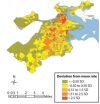(Press-News.org) Hundreds of tiny fungal particles found in the lungs of asthma sufferers could offer new clues in the development of new treatments, according to a team of Cardiff University scientists.
In the first large study of its type, published in the journal, BMC Infectious Diseases, a team of researchers from Cardiff University's School of Medicine have uncovered large numbers of fungi present in healthy lungs.
"Historically, the lungs were thought to be sterile," according to Dr Hugo van Woerden from Cardiff University's Institute of Primary Care and Public Health, who led the research.
"Our analysis found that there are large numbers of fungi present in healthy human lungs. The study also demonstrates that asthma patients have a large number of fungi in their lungs and that the species of fungi are quite different to those present in the lungs of healthy individuals," he added.
By examining the mucus or sputum of patients with and without asthma, the team found some 136 different fungal species with 90 fungal species more common in asthma patients and 46 were more common in healthy individuals.
Having established the presence of fungi in the lungs of patients with asthma, the researchers now hope this could lead to new lines of research and eventually, better treatments for sufferers.
"Establishing the presence of fungi in the lungs of patients with asthma could potentially open up a new field of research which brings together molecular techniques for detecting fungi and developing treatments for asthma.
"In the future it is conceivable that individual patients may have their sputum tested for fungi and their treatment adjusted accordingly," he adds.
This is not the first time the Cardiff researchers have made the link between fungi and asthma. Their previous research found that by removing fungi from people's homes, they could also help improve life for sufferers.
###
Notes:
A copy of the full paper is available at: www.biomedcentral.com/1471-2334/13/69
The team's previous research which found that removing fungi from people's homes, may also help improve life for sufferers is available at: www.ncbi.nlm.nih.gov/pmc/articles/PMC2117320/
For further information contact:
Professor Ian Matthews
Institute of Primary Care & Public Health
Cardiff University
School of Medicine
Neuadd Meirionnydd
Heath Park
Cardiff CF14 4YS
Tel: 029 20687246
Or
Dr Hugo Van Woerden
School of Medicine
Cardiff University
E-mail: vanwoerdenH1@cf.ac.uk
Tel: 07794 331801
Cardiff University
Cardiff University is recognised in independent government assessments as one of Britain's leading teaching and research universities and is a member of the Russell Group of the UK's most research intensive universities. Among its academic staff are two Nobel Laureates, including the winner of the 2007 Nobel Prize for Medicine, University Chancellor Professor Sir Martin Evans.
Founded by Royal Charter in 1883, today the University combines impressive modern facilities and a dynamic approach to teaching and research. The University's breadth of expertise in research and research-led teaching encompasses: the humanities; the natural, physical, health, life and social sciences; engineering and technology; preparation for a wide range of professions; and a longstanding commitment to lifelong learning.
Three major new Research Institutes, offering radical new approaches to neurosciences and mental health, cancer stem cells and sustainable places were announced by the University in 2010.
www.cardiff.ac.uk
Fungi offers new clues in asthma fight, say Cardiff scientists
2013-02-19
ELSE PRESS RELEASES FROM THIS DATE:
Is there a link between coffee drinking and mortality?
2013-02-19
New Rochelle, NY, February 19, 2013–A large study of nearly half a million older adults followed for about 12 years revealed a clear trend: as coffee drinking increased, the risk of death decreased. Study author Neal Freedman, PhD, MPH, National Cancer Institute, discusses the significance of these findings and the potential links between coffee drinking, caffeine consumption, and various specific causes of disease in an interview in Journal of Caffeine Research, a peer-reviewed journal from Mary Ann Liebert, Inc., publishers. The article is available free on the Journal ...
Fear, anger or pain -- Why do babies cry?
2013-02-19
VIDEO:
Spanish researchers have studied adults’ accuracy in the recognition of the emotion causing babies to cry. Eye movement and the dynamic of the cry play a key role in recognition.
Click here for more information.
Spanish researchers have studied adults' accuracy in the recognition of the emotion causing babies to cry. Eye movement and the dynamic of the cry play a key role in recognition.
It is not easy to know why a newborn cries, especially amongst first-time ...
Study shows reduced risk of preterm birth for pregnant women vaccinated during pandemic flu
2013-02-19
ATLANTA- Pregnant women who received the H1N1 influenza vaccine during the 2009 pandemic were less likely to have premature babies, and their babies weighed more on average.
Influenza infection during pregnancy is associated with adverse infant outcomes such as preterm birth. Emory researchers from the Rollins School of Public Health, in a joint study with Kaiser Permanente of Georgia and the Mid-Atlantic States, evaluated the effectiveness of the H1N1 influenza vaccine in pregnant women against adverse infant outcomes during the 2009 pandemic. They compared birth outcomes ...
Jurassic records warn of risk to marine life from global warming
2013-02-19
Researchers at Plymouth University, UK, believe that findings from fieldwork along the North Yorkshire coast reveal strong parallels between the Early Jurassic era of 180 million years ago and current climate predictions over the next century.
Through geology and palaeontology, they've shown how higher temperatures and lower oxygen levels caused drastic changes to marine communities, and that while the Jurassic seas eventually recovered from the effects of global warming, the marine ecosystems that returned were noticeably different from before.
The results of the Natural ...
Towards a new moth perfume
2013-02-19
A single mutation in a moth gene has been shown to be able to produce an entirely new scent. This has been shown in a new study led by researchers from Lund University in Sweden. In the long run, the researchers say that the results could contribute to tailored production of pheromones for pest control.
Male moths can pick up the scent of a female moth from a distance of several hundred metres. The females produce sexual pheromones – scent substances that guide the males to them. There are around 180 000 species of moth and butterfly in the world, and most of them communicate ...
Radio telescope, GPS use ionosphere to detect nuclear tests
2013-02-19
WASHINGTON--U.S. Naval Research Laboratory radio astronomer, Joseph Helmboldt, Ph.D., and researchers at Ohio State University Department of Civil, Environmental and Geodetic Engineering analyzed radio telescope interferometry and Global Positioning Satellite (GPS) data recorded of the ionosphere during one of the last underground nuclear explosions (UNEs) in the U.S., codenamed Hunters Trophy.
Situated in the Plains of San Agustin, 50 miles west of Socorro, New Mexico, twenty-seven 25-meter parabolic dish antennas collectively make up the National Radio Astronomy Observatory's ...
Private Security Industry must be made transparent and accountable, study concludes
2013-02-19
The true cost of war is being masked by the secretive and largely unaccountable activities of a private security industry, according to a new study.
These invisible costs of war – both in terms of casualties and financial resources – are not reported and are hard to find because contractors are not subject to the same reporting structures and laws as the regular military, and many of their activities are protected from Freedom of Information requests.
Private security firms – usually run by former senior figures in the military, civil service or politics – are increasingly ...
Could an old antidepressant treat sickle cell disease?
2013-02-19
ANN ARBOR, Mich. — An antidepressant drug used since the 1960s may also hold promise for treating sickle cell disease, according to a surprising new finding made in mice and human red blood cells by a team from the University of Michigan Medical School.
The discovery that tranylcypromine, or TCP, can essentially reverse the effects of sickle cell disease was made by U-M scientists who have spent more than three decades studying the basic biology of the condition, with funding from the National Institutes of Health.
Their findings, published in Nature Medicine, pave ...
Buying ad time just got easier
2013-02-19
EAST LANSING, Mich. — Today's consumers switch between media forms so often – from TV to laptops to smart phones – that capturing their attention with advertising has gone, as one CEO explained, from shooting fish in a barrel to shooting minnows.
Now, a Michigan State University business scholar and colleagues have developed the most accurate model yet for targeting those fast-moving minnows. The research-based model predicts when during the day people use the varying forms of media and even when they are using two or more at a time, an increasingly common practice known ...
Could a computer on the police beat prevent violence?
2013-02-19
ANN ARBOR, Mich. — As cities across America work to reduce violence in tight budget times, new research shows how they might be able to target their efforts and police attention – with the help of high-powered computers and loads of data.
In a newly published paper, University of Michigan Medical School researchers and their colleagues have used real police data from Boston to demonstrate the promise of computer models in zeroing in on violent areas.
They combined and analyzed information in small geographic units, on police reports, drug offenses, and alcohol availability ...






